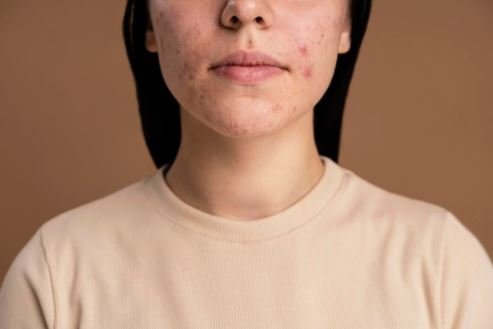According to Dr. Archit Aggarwal, here’s how to get rid of *deep* acne scars
If you have acne-prone skin, you’re well aware that breakouts aren’t the only issue you’ll face in your quest for a clear complexion.
Scarring is just as challenging to deal with, if not more so. Deep acne scars, on the other hand, can seem nearly impossible to remove.
Fortunately, many skincare and derma clinics offer various treatments to help reduce the appearance of deep acne scars.
We asked Dr. Archit Aggarwal, the best dermatologist in Faridabad about deep acne scars, including what causes them and how to treat them.
Contents
- What are the various kinds of acne scars?
- What types of acne scars are considered “deep acne scars”?
- What causes acne scars to be so profound?
- Is it possible to become free from intense acne scars by applying only skincare products?
- What options do I have for treating deep acne scars?
- The following are just a few treatments that can help reduce the appearance of acne scars:
What are the various kinds of acne scars?
There are four types of acne scars, according to Dr. Archit Aggarwal, the excellent dermatologist from Faridabad:
- Post-Inflammatory Erythema – These are red scars that indicate that acne has not fully healed. We see facial redness, which can indicate underlying inflammation.
- Atrophic scars– Scars that leave a deep depression in the skin. Rolling, boxcar, and icepick scars are the most common types of deep acne scars.
- Post-Inflammatory Pigmentary Change – Acne scars change the pigment; the marks can be lighter or darker based on the skin color, but the texture remains the same.
- Hypertrophic Scars: Hypertrophic scars are raised scars that become localized and thicken the skin.
What types of acne scars are considered “deep acne scars”?
It’s clear that not all acne scars are created equal, and some, such as deep acne scars, are more difficult to remove than others.
“These are the ‘atrophic scars,'” says Dr. Archit from Faridabad, referring to deep acne scars. “There are three types of scars: rolling, boxcar, and icepick.”
As the name implies, ice pick scars are deep, narrow scars that resemble an ice pick puncture. “Sharp, demarcated U-shaped appearance” describes boxcar scars.
They are usually well-defined in structure and can be shallow or deep.
Rolling scars on the skin are “large, poorly demarcated depressions.” They’re usually superficial, but they’re still interesting.
What causes acne scars to be so profound?
You might be predisposed to scarring even if you’re careful with your skin and don’t pick at it when you have acne.
“Genetics, inflammation, acne relapses, and time to effective treatment are all factors that contribute to deep acne scarring.” Dr. Archit Aggarwal, the leading dermatologist, explains, “We encourage patients with a family history of scarring and acne to seek treatment as soon as possible to avoid the formation of scars.”
Is it possible to become free from intense acne scars by applying only skincare products?
Yes, in theory, but it would be a time-consuming method with insignificant results.
Retinoids and other collagen-stimulating agents may help increase collagen production, while sunscreen can help prevent further collagen degradation.
“However, it only rarely returns to the ‘original’ skin. Progress would be slow, and most of the time, only minor gains would be visible.
Dr. Archit Aggarwal clarifies deep acne scars require procedural intervention to make a significant difference in the appearance of scars.
What options do I have for treating deep acne scars?
According to Dr. Archit Aggarwal, the best dermatologist from Faridabad, there are two basic approaches to getting rid of acne scars: prevention and treatment.
Sunscreen is necessary to prevent scars from forming or worsening by minimizing collagen degradation over time.
In addition to the procedural scar treatment, anti-aging products such as retinoids and vitamin C can help stimulate collagen production.
When it comes to treatment, it’s important to remember that everyone’s face has a unique combination of scars.
As a result, a mixed procedure approach is usually preferable to perform only one type of procedure.
There is an increased risk of post-inflammatory hyper or hypopigmentation in Filipino or skin of color for all procedures.
Most dermatologists prefer to use feebler strength except for reoccurred treatment sessions to be safe and avoid causing too much damage and risking side effects.
The following are just a few treatments that can help reduce the appearance of acne scars:
- Pulsed Light Treatments – stimulate collagen production deep within the dermis.
- Laser resurfacing -stimulates collagen production deep within the dermis by creating regulated wounds within the skin.
- Fillers – To plump up the appearance of scars, substances such as hyaluronic acid or biomodulators are injected into the skin over the wounds.
- Chemical Peels: These peels remove the top layer of the skin, allowing collagen production to occur beneath it.
- Botulinum Toxin Injections: These injections help to reduce scar tissue stress and visibility.
- Surgery – In a procedure known as punch excision, the specialist can cut out specific acne scars and close the wound with skin tape or stitches.
- Microneedling: The doctor uses different depths of a needle studded device to roll over the scars for collagen induction.



